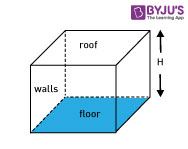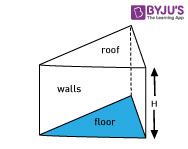Area Of prism
Prism Definition
A Prism is a solid figure with a uniform cross section. Here are some of the examples of the Prisms:
Rectangular based prism

Circular based prism (Cylinder)

Triangular based prism

Surface area of Prism
The surface area of a prism is always equal to the sum of the areas of all its faces, which includes the floor, walls, and roof. Because in a prism, the roof and the floor have same shape and their surface areas is always same which can be found out by
Surface area of Prism = 2 x area of the base+ perimeter of the base x Height
The actual formula to find out the circumference is used depending upon the shape of the base
Rectangular Prism

Base Shape: Rectangle with length L and with width W
Area of the base: L*W
Perimeter: 2(L+W)
Surface area= 2LW+2(L+W)H
Circular based prism (Cylinder)

Base Shape: Circle with radius of R
Area of the Base: PR^2
Perimeter of the base: 2PR
Surface area= 2PR^2 + 2PRH
Triangular based prism

Base Shape: Triangle with base B, height H and slides S1, S2 and S3
Area of the base: ½ B*H
Perimeter of the base: S1 + S2 +S3
Surface area = BH + (S1+S2+S3)H
To know more about surface area of a prism formula, you can visit us at byjus.com
Frequently Asked Questions
What is Prism?
The prism shape in maths can be defined as a solid figure with a uniform cross-section.
What is Meant by the Area of a Prism?
The area of a prism is defined as the total amount of space that the prism encloses in a three-dimensional space.
What is the Formula for Surface Area of a Prism?
The surface area of a prism is the summation of twice the area of the base and the product of perimeter of base and height. So,
Surface area of Prism = 2 x area of the base + perimeter of the base x Height
What is the Surface Area of a Rectangular Prism?
The surface area of a rectangular prism is:
A = 2(lb+lh+bh)